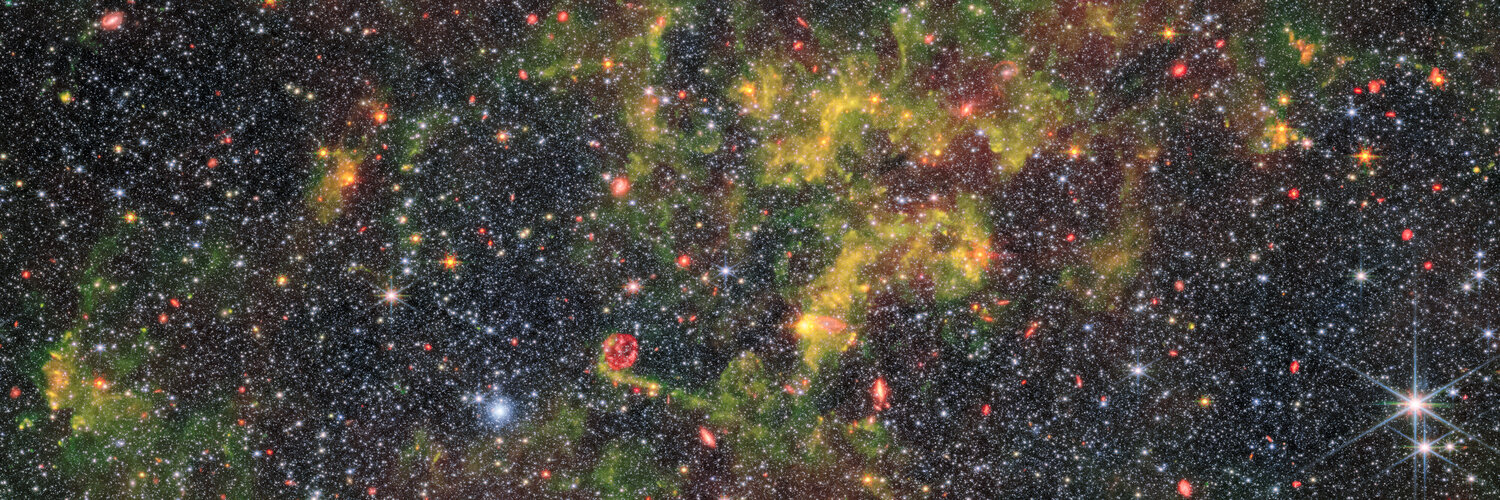Space News & Blog Articles
The life and times of dust
 Image:
Image:
This image shows the irregular galaxy NGC 6822, which was observed by the Near-InfraRed Camera (NIRCam) and Mid-InfraRed Instrument (MIRI) mounted on the NASA/ESA/CSA James Webb Space Telescope. As their names suggest, NIRCam and MIRI probe different parts of the electromagnetic spectrum. This allows the instruments to observe different components of the same galaxy, with MIRI especially sensitive to its gas-rich regions (the yellow swirls in this image) and NIRCam suitable for observing its densely packed field of stars.
NGC 6822 lies about 1.5 million light-years away, and is the Milky Way’s nearest galactic neighbour that is not one of its satellites. It has a very low metallicity, meaning that it contains very low proportions of elements that are not hydrogen and helium. Metallicity is an absolutely key concept in astronomy, in part because elements other than hydrogen and helium are largely produced by stars over their lifetimes. Therefore, in the very early Universe (before the first generation of stars had been born, lived and died) everything had very low metallicity. This makes contemporary low-metallicity objects (like NGC 6822) objects of interest for understanding how processes such as the evolution of stars and the life cycle of interstellar dust likely occurred in the early Universe. This was the motivation for these observations of NGC 6822 with Webb: to better understand how stars form and how dust evolves in low-metallicity environments.
The study of NGC 6822 has an interesting history that long predates modern investigations with Webb. It was first discovered by E. E. Barnard, who presented his discovery in a very brief paper in 1884 in The Sidereal Messenger: a short-lived but important American monthly astronomical journal that was published between 1882 and 1891. As with many astronomical objects that appeared diffuse with telescopes of the time, NGC 6822 was miscategorised as an "exceedingly faint nebula".
Over the next few years, a series of confusions arose around NGC 6822 over its apparent size, brightness, and even what kind of object it was, because astronomers at the time did not properly account for how different the same object might look with different telescopes. Edwin Hubble, namesake of the NASA/ESA Hubble Space telescope, went on to study NGC 6822 in depth and published a far more detailed paper of his own in 1925. This work was exceptionally important for humanity’s evolving understanding of the Universe, because, in Hubble’s own words: "N.G.C. 6822, [was] the first object definitely assigned to a region outside the galactic system". This paper contributed to solving the debate that was raging amongst astronomers about the extent of the Universe at the time by demonstrating that there were astronomical objects that lay beyond the Milky Way. The study of this galaxy was notably continued by Susan Keyser, who was the first woman to receive a PhD in astronomy from Caltech. Her 1966 thesis remained the most thorough investigation of this galaxy until the 2000s. Now, the study of this key local galaxy is being continued by Webb.
[Image Description: A dense field of stars with clouds of gas and dust billowing across it. The clouds are patchy and wispy, dense and glowing parts obscuring the centre of the image. Bright galaxies with various shapes and sizes shine through the gas and stars. Some of the star images are a bit larger than the rest, with visible diffraction spikes; two foreground stars are bright in the lower-right corner.]
When you subscribe to the SpaceZE News Feed, we will send you an e-mail when there are new updates on the site so you wouldn't miss them.

